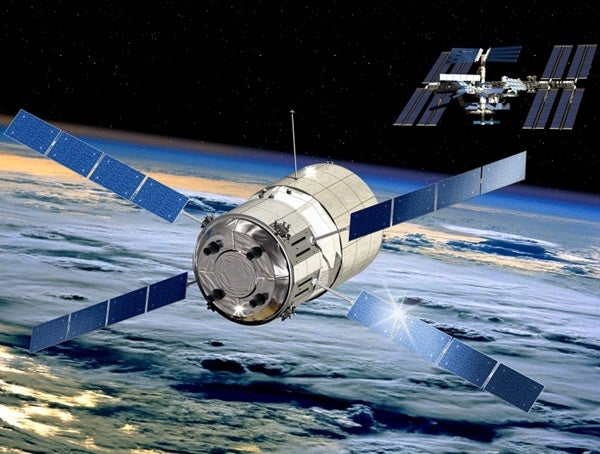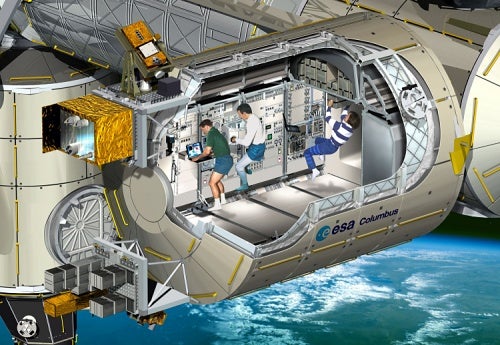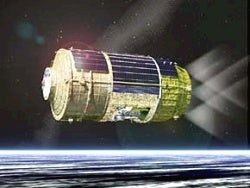Two years after grounding the space shuttle, assembly of the International Space Station (ISS) is at a near standstill. But if all goes according to a new plan approved by a consortium of international partners involved with the outpost, construction will resume later this year. Last Wednesday, while the station’s current two-man crew was finishing a space walk, leaders of the world’s space agencies gathered in Montreal to discuss the orbiting facility’s future.
The heads of the partnering agencies endorsed a strategy that outlines the station’s fate — specifically, the deadline for completion of ISS construction, its working life span, and cooperation terms. Representatives from the United States, Canada, Russia, Japan and Europe — the five partners involved in managing, building, and operating ISS — all vowed to complete the station by the end of this decade.
Since the Columbia disaster, NASA Administrator Sean O’Keefe says, over $1.5 billion has been invested in modifying the shuttles, and everything is on track to restart construction of ISS this fall. If the shuttles check out on two test flights scheduled for May and July, they will be ready to begin ferrying components to the station once more. Last week’s meeting did come up with a precise sequence for assembly, but no specific dates can be decided upon until the shuttle successfully goes through its shakedown flights.
“The first step in this process is to return the shuttle to flight, and to complete the International Space Station by the end of the decade, and retire the shuttle thereafter,” said O’Keefe.
Currently only half-built, ISS construction is dependent on the shuttle. Delays have meant rising costs for the nations involved. O’Keefe reiterated NASA’s commitment to deliver the station’s major components. However, for safety reasons, he wants the job done in the fewest flights possible. “While we’ll never eliminate the risk of flying shuttles, ” O’Keefe said, “the best way to minimize the risk is to minimize the number of flights.”
The first two flights will deliver fresh supplies to the space station. The third, now tentatively scheduled for December 2005, will support resumed construction. STS-115, the first of 28 shuttle missions needed to complete ISS, will supply a new set of solar arrays and batteries.
Since the shuttle has been grounded, ISS has hosted only two astronauts at any one time. The partners at the meeting agreed that once the shuttle is flying, the number of station residents would return to three. Crew size was reduced because only the three-seat Russian Soyuz spacecraft is available to taxi astronauts. If all remains on schedule, ISS will have a full crew of six by January 2009.
Speaking at a joint press conference, representatives of the world’s space agencies acknowledged that the return of the shuttle would be vital to successful completion of ISS. “It’s the vehicle that brings all the bits and pieces to build the station, like solar panels and the modules that the Europeans and Japanese want to bring up,” explained Marc Garneau, president of the Canadian Space Agency.
“Between now and the May-June time frame, there are still some technical hurdles to be crossed by NASA,” added Jean-Jacques Dordain, head of the European Space Agency (ESA). “So we shall see.”
International partners are getting fidgety, as many ISS components are ready to go. Because of these delays, delivery of the two highest-profile science labs, the Japanese Experiment Module (JEM) and the European Columbus module, has been bumped up in the ISS assembly schedule.
The agencies also agreed to expand future ISS transportation and supply options, and to use a mix of vehicles from across the partnership. Currently, support comes from the Russian Soyuz spacecraft, the U.S. space shuttle, and the automated resupply capabilities provided by Russian Progress vehicles. Dordain confirmed ESA has plans to join this support effort by the end of this year with a new-generation European Automated Transport Vehicle (ATV) dubbed Jules Verne.
Meanwhile, Keiji Tachikawa, president of the Japan Aerospace Exploration Agency (JAXA) announced his nation will resume launch of its two-stage H2-A launcher this month. The H2-A has been on hiatus since a launch failure in November 2003. Tachikawa believes the H2-A is critical in building Japan’s future space program. The country’s own cargo ship, the H2 Transfer Vehicle, is also in the works and will be ready in 2008.
O’Keefe made it quite clear that while the United States will continue to participate in the construction and use of ISS well into 2015, NASA will be guided by the new “Moon, Mars and Beyond” initiative President Bush set out last year. American experiments and research, therefore, will center on exploring the challenges of long-duration space flight associated with interplanetary voyages rather than low-Earth-orbit missions.
Anatolii Perminov, head of the Russian Federal Space Agency, agreed ISS is the perfect platform to conduct research that would lead to humans going to Mars. However, he said, lunar missions should remain the near-term focus.
“I am talking about human exploration of the Moon, including human settlements and bases,” Perminov said. “Only after we conduct all this can we dream about flying to Mars.”












